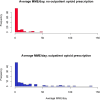In inpatients with cirrhosis opioid use is common and associated with length of stay and persistent use post-discharge
- PMID: 32101574
- PMCID: PMC7043759
- DOI: 10.1371/journal.pone.0229497
In inpatients with cirrhosis opioid use is common and associated with length of stay and persistent use post-discharge
Abstract
Background: Previous studies have demonstrated that opioids are often prescribed and associated with complications in outpatients with cirrhosis. Less is known about opioids among hospitalized patients with cirrhosis. We aimed to describe the patterns and complications of opioid use among inpatients with cirrhosis.
Methods: This retrospective cohort study included adult patients with cirrhosis admitted to a single hospital system from 4/4/2014 to 9/30/2015. We excluded hospitalizations with a surgery, invasive procedure, or palliative care/hospice consult in order to understand opioid use that may be avoidable. We determined the frequency, dosage, and type of opioids given during hospitalization. Using bivariable and multivariable analyses, we assessed length of stay, intensive care unit transfer, and in-hospital mortality by opioid use.
Results: Of 217 inpatients with cirrhosis, 118 (54.4%) received opioids during hospitalization, including 41.7% of patients without prior outpatient opioid prescriptions. Benzodiazepines or hypnotic sleep aids were given to 28.8% of opioid recipients. In the multivariable model, younger age and outpatient opioid prescription were associated with inpatient opioids. Hospitalization was longer among opioid recipients (median 3.9 vs 3.0 days, p = 0.002) and this difference remained after adjusting for age, cirrhosis severity, and medical comorbidities. There was no difference in intensive care unit transfers and no deaths occurred. At discharge, 22 patients were newly started on opioids of whom 10 (45.5%) had opioid prescriptions at 90 days post-discharge.
Conclusion: In non-surgical inpatients with cirrhosis, opioid prescribing was common and associated with prolonged length of stay. A high proportion of patients newly discharged with opioid prescriptions had ongoing prescriptions at 90 days post-discharge.
Conflict of interest statement
The authors have declared that no competing interests exist.
Figures


Similar articles
-
Perioperative Opioid and Nonopioid Prescribing Patterns in AVF/AVG Creation.Ann Vasc Surg. 2021 Apr;72:290-298. doi: 10.1016/j.avsg.2020.09.002. Epub 2020 Sep 16. Ann Vasc Surg. 2021. PMID: 32949735
-
Opioid prescribing patterns among postpartum women.Am J Obstet Gynecol. 2018 Jul;219(1):103.e1-103.e8. doi: 10.1016/j.ajog.2018.04.003. Epub 2018 Apr 7. Am J Obstet Gynecol. 2018. PMID: 29630887 Free PMC article.
-
Implementing an opioid reduction protocol in renal transplant recipients.Am J Surg. 2020 Nov;220(5):1284-1289. doi: 10.1016/j.amjsurg.2020.06.055. Epub 2020 Jul 1. Am J Surg. 2020. PMID: 32650975 Free PMC article.
-
Description and Impact of a Comprehensive Multispecialty Multidisciplinary Intervention to Decrease Opioid Prescribing in Surgery.Ann Surg. 2019 Sep;270(3):452-462. doi: 10.1097/SLA.0000000000003462. Ann Surg. 2019. PMID: 31356279 Review.
-
A Review of Inpatient Opioid Consumption and Discharge Prescription Patterns After Orthopaedic Procedures.J Am Acad Orthop Surg. 2020 Apr 1;28(7):279-286. doi: 10.5435/JAAOS-D-19-00279. J Am Acad Orthop Surg. 2020. PMID: 31633659 Review.
Cited by
-
Opioid use and risks in candidates and recipients of liver transplant.Liver Transpl. 2025 Feb 1;31(2):231-241. doi: 10.1097/LVT.0000000000000388. Epub 2024 Apr 29. Liver Transpl. 2025. PMID: 38669598 Review.
-
Hepatic Encephalopathy-Related Hospitalizations in Cirrhosis: Transition of Care and Closing the Revolving Door.Dig Dis Sci. 2022 Jun;67(6):1994-2004. doi: 10.1007/s10620-021-07075-2. Epub 2021 Jun 24. Dig Dis Sci. 2022. PMID: 34169435 Free PMC article. Review.
-
Opioid Use Is More Common in Nonalcoholic Fatty Liver Disease Patients with Cirrhosis, Higher BMI, and Psychiatric Disease.Dig Dis. 2021;39(3):247-257. doi: 10.1159/000511074. Epub 2020 Aug 24. Dig Dis. 2021. PMID: 32836224 Free PMC article.
-
Changing Prevalence of Medication Use in People with Cirrhosis: A Retrospective Cohort Study Using Pharmaceutical Benefits Scheme Data.Drugs Real World Outcomes. 2023 Dec;10(4):605-618. doi: 10.1007/s40801-023-00390-2. Epub 2023 Oct 13. Drugs Real World Outcomes. 2023. PMID: 37828144 Free PMC article.
References
-
- Rogal SS, Bielefeldt K, Wasan AD, Lotrich FE, Zickmund S, Szigethy E, et al. Inflammation, psychiatric symptoms, and opioid use are associated with pain and disability in patients with cirrhosis. Clin Gastroenterol Hepatol. 2015;13(5):1009–16. Epub 2014/12/03. 10.1016/j.cgh.2014.10.029 - DOI - PMC - PubMed
Publication types
MeSH terms
Substances
Grants and funding
LinkOut - more resources
Full Text Sources

